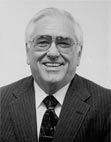 Bill Coate -- "The Madera Method"
Bill Coate -- "The Madera Method"The 6th grade students tread lightly among the graves, touching the markers and reading the epitaphs of Madera's pioneers. It is their first week of school, and already they are on a field trip to launch their year-long Social Studies/Language Arts project, "Tales the Tombstones Tell." Suddenly one of the departed speaks to the group from across the ages via an epitaph on the tombstone. The students are captivated and make a pact to resurrect that person in the only way humanly possible - they agree to research his/her life and write the story for the entire town to read.
Using the information gleaned from the tombstone as a point of departure, the students set out to follow the paper trail left by this pioneer. In small groups after school they visit the local archives. They recover the death certificate. They copy the obituary. They locate the person on the United States Census Reports. Armed with these primary source documents, the students then expand their research. They go after wills and inventories, military records, tax rolls, and land deeds. With each new find, the intensity of their excitement surges. The young sleuths realize that they are plowing new ground; they are pulling knowledge out of the darkness and into the light. They are using the raw material of history to breathe life into old, dry bones.
When their research is as complete as one school year will allow, the class begins to assimilate its data. Students analyze each primary document to construct a chronology of their pioneer's life. Then they correlate that personal data with the pioneer's political, social, and economic milieu. Significant national, state, and local events that would have impacted the life of the deceased are uncovered and studied. Excitement in the classroom builds with each new bit of information. Soon the class feels it really knows its pioneer, and their sleuthing is over. Now it's time for synthesis. It's time to write.
Each student selects a year in the life of the pioneer and assumes his/her identity. Then they write a diary that could have been written by that person. Although the vehicle is fictional, each entry is based upon the solid facts of rigorous research. When the writing is complete, the student work is published. The book is then released at a "young authors reception," to which the public is invited. The true measurement of the success of the project lies in the sustained excitement of the students. The thrill of discovery never abates. The passionate debates over the meaning of a document reveal the extent to which each student is connected both intellectually and emotionally. And in the end, when the student walks out of the door with his/her book in hand, a young face reflects the joy and pride of being able to say, "I am a writer."